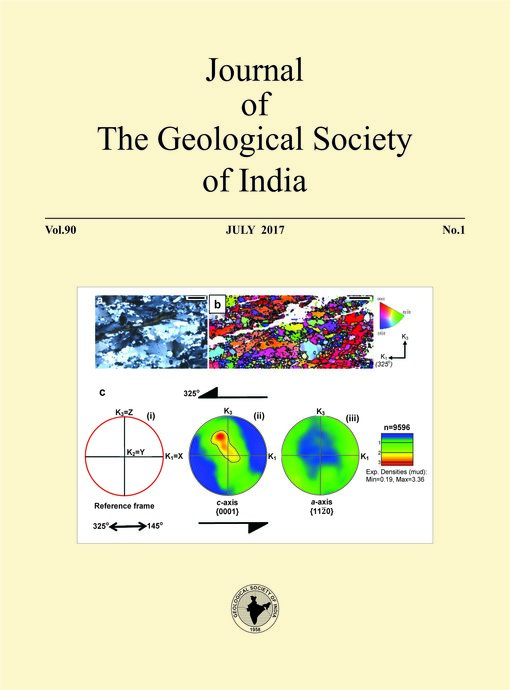Groundwater Quality Assessment for Drinking Purpose in Raipur City, Chhattisgarh Using Water Quality Index and Geographic Information System
DOI:
https://doi.org/10.1007/s12594-017-0665-0Abstract
An effort has been made to comprehend the groundwater quality of Raipur city for drinking purpose utilizing Water Quality Index (WQI) and Geographic Information System (GIS) techniques. In this study thirty four groundwater samples were collected during May, 2015. Standard methods has been adopted in groundwater sampling which are prescribed by the American Public Health Association (APHA, 1995). Eight water quality parameters have been considered to ascertained water quality index viz. pH, chloride, fluoride, calcium, magnesium, alkalinity, hardness and nitrate. The Bureau of Indian Standard (BIS, 2009) has been considered to assess the suitability of groundwater for drinking purposes and for the calculation of WQI. This study reveals that 76% area is falling under excellent, very good and good category and 24% area is falling under poor, very poor and unfit category as per the WQI classification. The predicted accuracy of the obtained result is around 97.05% reflecting capability of adopted techniques. Anthropogenic activities are influencing the groundwater quality of the study area. The present study is helpful in proper planning and management of available water resource for drinking purpose.Downloads
Metrics
Issue
Section
Downloads
Published
How to Cite
References
Anitha, P., Charmaine, J. and Nagaraja, S. (2011) Evaluation of groundwater quality in and around Peenya industrial area of Bangalore, South India using GIS techniques. Environ Monit Assess. doi:10.1007/ s10661-0112244-y.
Arumugam, K. (2010) Assessment of Groundwater Quality in Tirupur Region, PhDThesis(Unpublished). Anna University, Chennai
APHA (1995) Standard method for the examination of water and waste water (14th Ed.) Washington D.C. Amer. Public Health Association, no.409A, pp.316-317.
BIS (Bureau of Indian Standard) (2009) 10500, Indian standard drinking water specification, Second revision, pp.1-24.
ESRI Arc USER (2004) Spatial Interpolation July 2004). //http: www.esri.com acccesed 25 Oct 2011.
Foster, S., Hirata, R., Gomes, D., D'Elia, M. and Paris, M. (2002) Groundwater quality protection: a guide for water utilities, munciple authorities and environment agencies. The international Bank for Reconstruction and Development/World Bank Technical Paper. Washington, D.C.
Gibrilla, A., Bam, E.K.P., Adomako, D., Ganyaglo, S., Dampare, S.B., Ahialey, E.K. and Tetteh, E. (2011) Seasonal Evaluation of raw, treated and distributed water quality from the barekese dam (river offin) in the ashanti region of Ghana. Water Quality, Exposure and Health v.3(3-4), pp.157– 174. doi: 10.1007/s12403-011-0053-8
GSI (2005) District Resource Map (DRM). Geological Survey of India. Govt. of India, Kolkata
Ghezelsofloo, A.A. and Ardalan, V.R. (2012) Identifying the major sources of groundwater contaminants and estimating their pollutions potential in the Mashhad plain aquifer. Groundwater Modeling and Management under Uncertainty Proceedings of the Sixth IAHR International Groundwater Symposium Kuwait, pp.69-76. doi: 10.1201/b13167-13
Jat, M.K., Khare, D. and Garg, P.K. (2009) Urbanization and its impact on groundwater: a remote sensing and GIS-based assessment approach. The Environmentalist, v.29(1), pp.17–32. doi: 10.1007/s10669-008-9176-2
Jhariya, D.C., Shandilya, A.K. and Dewangan, R. (2012) Nitrate Pollution in the Groundwater Around Sagar Town, Madhya Pradesh, India. International Conference on Chemical, Ecology and Environmental Sciences (ICEES'2012), Bangkok, pp.151-154
Ketata, M., Gueddari, M. and Bouhlila, R. (2011) Use of geographical information system and water quality index to assess groundwater quality in El Khairat deep aquifer (Enfidha, Central East Tunisia). Arabian Jour. Geosci., v.5(6), pp.1379–1390. doi:10.1007/s12517-011-0292-9
Khan, R. and Jhariya, D.C. (2016) Land Use, Land Cover Change Detection Using Remote Sensing and Geographic Information System in Raipur Municipal Corporation Area, Chhattisgarh.SSARSC Internat. Jour. Geo Science and Geo Informatics. v.3(1), pp.1-4. http://www.ssarsc.org/ volumes/ijgsgi/volume3/SSARSC-IJGSGI_1.pdf.
Krishna Kumar, S., Chandrasekar, N., Seralathan, P., Godson, P.S., Magesh, N.S. (2011) Hydrogeochemical study of shallow carbonate aquifers, Rameswaram Island, India. Environ. Monit. Assess., v.184(7), pp.4127–4139
Kumar, S.K., Logeshkumaran, A., Magesh, N.S., Godson, P.S., Chandrasekar, N. (2014) Hydro geochemistry and application of water quality index (WQI) for groundwater quality assessment, Anna Nagar, part of Chennai City, Tamil Nadu, India. Appld. Water Sci., doi: 10.1007/s13201-0140196-4
Oke, A.O., Sangodoyin, A.Y., Ogedengbe, K. and Omodele, T. (2013) Mapping of river water quality using inverse distance weighted interpolation in Ogun-osun river basin, Nigeria Landscape & Environ., v.7(2), pp.48-62.
Milovanovic, M. (2007) Water quality assessment and determination of pollution sources along the Axios/Vardar River, Southeastern Europe. Desalination, v.213, pp.159-173.
Mtetwa, S., Kusangaya, S. and Schutte, C.F. (2003) The application of geographic information system (GIS) in the analysis of nutrient loadings from an agro-rural catchment. Water SA, v.29(2), pp.189-193.
Ramakrishnaiah, C.R., Sadashivaiah, C., Ranganna, G. (2009) Assessment of Water Quality Index for the Groundwater in Tumkur Taluk, Karnataka State, India. E-Journal of Chemistry, v.6(2), pp.523–530. doi: 10.1155/ 2009/757424
Rubia, Jhariya, D.C. and Singh, V.K. (2015) Urbanization and its impact on Groundwater: An Overview. Workshop on Groundwater issues and challenges in Chhattisgarh state with special reference to its Conservation, Security and Quality. Central Ground Water Board, NCCR, Ministry of Water Resources, River Development & Ganga Rejuvenation. Govt. of India, pp.127-136.
Sadat-Noori, S.M., Ebrahimi, K. and Liaghat, A.M. (2013) Groundwater quality assessment using the Water Quality Index and GIS in Saveh-Nobaran aquifer, Iran. Environ. Earth Sci., v.71(9), pp.3827–3843. doi: 10.1007/ s12665-013-2770-8
Sadat-Noori, S.M., Ebrahimi, K., Liaghat, A.M. (2014) Groundwater quality assessment using the Water Quality Index and GIS in Saveh-Nobaran aquifer, Iran. Environ Earth Sci., v.71, pp.3827–3843, doi: 10.1007/ s12665-013-2770-8
Sinha, U.K., Kulkarni, K.M., Sharma, S. and Bodhankar, N. (2002) Assessment of aquifer system using isotope techniques in urban centers Raipur, Calcutta, Jodhpur, India. IAEA, 77-85. http://www.iaea.org/inis/collection/ NCLCollectionStore/_ Public/33/037/33037887.pdf
Tiwari, A.K., Singh, A.K., Singh, A.K., Singh, M.P. (2015) Hydrogeochemical analysis and evaluation of surface water quality of Pratapgarh district, Uttar Pradesh, India. doi: 10.10007/s13201-015-0313-z
Todd, D.K. (1976) Groundwater Hydrology. John Wiley and sons Inc.Newyork
Wakode, H.B., Baier, K., Jha, Ahmed, S. and Azzam, R. (2014) Assessment of Impact of Urbanization on Groundwater Resources using GIS TechniquesCase Study of Hyderabad, India. Internat. Jour. Environ. Res., v.8(4), pp.1145–1158.
Xingmei, L., Jianjun, W. and Jianming, X. (2006) Characterizing the risk assessment of heavy metals and sampling uncertainty in paddy field by geostatistics and GIS. Environ. Pollution, v.141, pp.257-264.

 D. C. Jhariya
D. C. Jhariya






